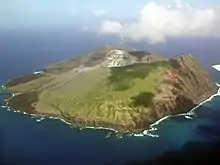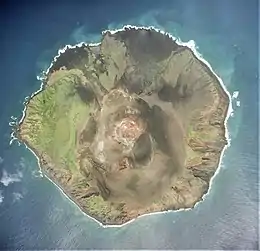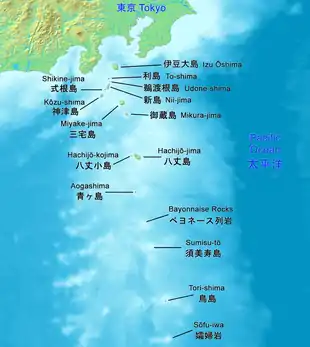Tori-shima (Izu Islands)
Tori-shima (Japanese: 鳥島, Hepburn: Tori-shima or Izu-no-Tori-shima) 'Bird Island', is an uninhabited Japanese island in the Pacific Ocean.[1] The volcanic island is part of the Izu Islands.[2]

| Native name: 鳥島 | |
|---|---|
 | |
 | |
| Geography | |
| Location | Izu Islands |
| Coordinates | 30°28′48″N 140°18′22″E |
| Archipelago | Izu Islands |
| Area | 4.79 km2 (1.85 sq mi) |
| Coastline | 6.5 km (4.04 mi) |
| Highest elevation | 394 m (1293 ft) |
| Administration | |
Japan | |
| Prefecture | Tokyo |
| Subprefecture | Hachijō Subprefecture |
| Demographics | |
| Population | 0 |
Geography
Tori-shima is located in the Philippine Sea approximately 600 km (373 mi) south of Tokyo and 76 km (47 mi) north of Lot's Wife. The roughly circular-shaped island is listed as a Class A active volcano by the Japan Meteorological Agency. The island is the above-water portion of a submarine volcano, whose submerged caldera portion to the north of the island continues to erupt underwater. Volcanic activity on the island itself was last recorded in 2002, accompanied by earthquake swarms. The main peak on the island, Io-zan (硫黄山) has a height of 394 m (1,293 ft), and the island has a circumference of 6.5 km (4.0 mi). The total area of the island is 4.79 km2 (1.85 sq mi).
History
Tori-shima was known to Japanese fishermen and mariners since at least the early Edo period, but was uninhabited aside from occasional shipwreck survivors. In 1841, 14-year-old Nakahama Manjirō and four friends were shipwrecked on Tori-shima until rescued by the American whaler ship John Howland commanded by William H. Whitfield. Japanese writer Akira Yoshimura researched and wrote about 15 similar instances. The island was settled in Meiji period, with the primary economic activity being the gathering of guano from the abundant short-tailed albatross, who use the island as their nesting grounds. A major volcanic eruption was recorded in 1871. The island was administratively grouped with the Ogasawara islands in August 1898, but was transferred to the administration of Hachijojima in April 1901. The population of 150 inhabitants was killed by the major volcanic eruption of 1902.[3] Torishima was never repopulated.
Since the 1930s, the Yamashina Institute for Ornithology has taken a very active role in researching and attempting to preserve the local seabird species, especially the short-tailed albatross, which had been reduced to an estimated 50 birds by 1933. The Japan Meteorological Agency established a weather station and volcanic research station on the island in 1947, but this was abandoned in 1965 due to volcanic activity and earthquakes. On November 1, 1954 Tori-shima was proclaimed a protected bird sanctuary. This designation was increased to that of a protected national Natural monument on May 10, 1965. It can only be visited by research scientists with special permission, and landing on the island is very difficult due to heavy seas and lack of suitable landing beaches or facilities. Tour boats which take people around the island to view the birds are popular, but these tours are not permitted to land on the island. Researchers normally travel to the island by chartered government helicopter.
Tori-shima, along with the other Izu Islands, is officially part of Tokyo Metropolis, and also falls within the borders of the Fuji-Hakone-Izu National Park.
Flora and fauna
Repeated volcanic eruptions in 1939 and 2002 have set the flora on Tori-shima back to initial stages in the ecological succession. Plants such as Vitex rotundifolia and hydrangea are found near the shoreline, and Chrysanthemum pacificum and Japanese black pine in sheltered areas inland, but most of the central portion of the island remains as volcanic ash and rock.
The island is home to several tens of thousands of breeding pairs of Tristram's storm petrel and other birds such as Japanese murrelet, black-footed albatross, common kestrel and blue rock thrush, but the short-tailed albatross population has been very slow to recover, with recovery hampered by the presence of large numbers of black rats, the only remaining mammal on the island. Humpback whales and dolphins often appear around the island during migration and breeding seasons.[4] Tori-shima is the primary and one of only two remaining breeding sites for the Short-tailed albatross.[5] The island has been recognised as an Important Bird Area (IBA) by BirdLife International.[6]
See also
- List of volcanoes in Japan
- List of islands of Japan
- List of islands
- Desert island
Notes
- Nussbaum, Louis-Frédéric. (2005). "Torishima," Japan Encyclopedia, p. 987.
- Nussbaum, "Izu Shotō" at p. 412.
- "Inhabitants of Island all Killed by Volcano; the 150 Japanese Residents of Torishima Dead -- Eruption Still Proceeding". New York Times. August 19, 1902. Retrieved October 8, 2014. (subscription required)
- アホウドリ 復活への展望 - 鳥島ウォーカー
- Eda, Masaki; Koike, Hiroko; Kuro-o, Masaki; Mihara, Shozo; Hasegawa, Hiroshi; Higuchi, Hiroyoshi (2011-09-28). "Inferring the ancient population structure of the vulnerable albatross Phoebastria albatrus, combining ancient DNA, stable isotope, and morphometric analyses of archaeological samples". Conservation Genetics. 13 (1): 143–151. doi:10.1007/s10592-011-0270-5. ISSN 1566-0621. S2CID 15383545.
- "Torishima island". BirdLife Data Zone. BirdLife International. 2021. Retrieved 6 February 2021.
References
- Teikoku's Complete Atlas of Japan, Teikoku-Shoin Co., Ltd. Tokyo 1990, ISBN 4-8071-0004-1
External links
| Wikimedia Commons has media related to Torishima. |
- Short Tailed Albatross
- Tori-shima from the north
- Map of Torishima by Japan Meteorological Agency (in Japanese)
- Yamashina Research Institute page on Torishima with photos (in Japanese)
- Entry at Oceandots.com at the Wayback Machine (archived December 23, 2010)
- Tori-shima Location and description of island and volcano.
- Tori-shima Enlargement of the excellent aerial photo of the island from the south in the previous link.
- Izu-torishima Photos during and after 2002 eruption.